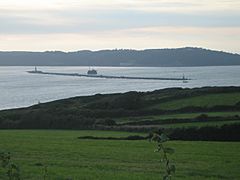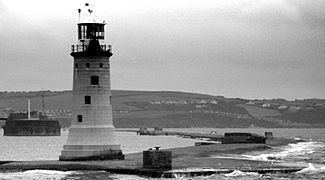Plymouth Breakwater facts for kids
| Year first constructed | 1841 |
|---|---|
| Year first lit | 1844 |
| Construction | stone tower |
| Tower shape | cylindrical tower with balcony and lantern |
| Markings / pattern | white tower and lantern |
| Original lens | 2nd order fixed catadioptric |
| Characteristic | Fl WR 10s. Iso W 4s. at 12 metres (39 ft) |
| Fog signal | blast every 15s. |
The Plymouth Breakwater is a huge stone wall built in the sea. It's about 1,560 meters (1 mile) long and protects Plymouth Sound in Devon, England. This amazing structure keeps the waters calm for ships anchored near Plymouth.
The breakwater is 13 meters (43 feet) wide at the top and 65 meters (213 feet) wide at its base. It sits in about 10 meters (33 feet) of water. Building it was a massive project! Around 4 million tons of rock were used. Construction started in 1812 and cost a huge amount of money for that time.
Contents
Building the Breakwater: A Big Project
Back in 1806, during the Napoleonic Wars, it was very important to make Plymouth Bay a safe place for the British Navy's ships. A leader named Lord St. Vincent asked two engineers, John Rennie and Joseph Whidbey, to come up with a plan.
In 1811, the order was given to start building the breakwater. Joseph Whidbey was in charge of making sure everything happened. This job needed great engineering skills and careful planning. It also involved managing many people and resources. Nearly 4 million tons of stone were dug up and moved using special ships designed by the engineers.
The very first stone was placed on August 8, 1812. The breakwater followed a path over several underwater rocks. By 1814, it was finished enough to protect large warships. Even Napoleon, on his way to exile in 1815, was impressed by it! He reportedly called the breakwater "a grand thing."
After some big storms in 1817 and 1824, the design of the breakwater was made even stronger. John Rennie passed away in 1821. His last ideas for the breakwater included plans for a lighthouse. Joseph Whidbey continued working on the breakwater and other projects until he retired around 1830. Rennie's sons, George and Sir John, then finished the work.
The Plymouth Breakwater Lighthouse
The Plymouth Breakwater Lighthouse stands at the very end of the breakwater. It was designed by Walker & Burgess for the British Navy. Building the granite tower began in 1841 and finished in 1843.
The lighthouse started working in June 1844. Soon after, a horse-drawn bus full of passengers and a military band even drove all the way along the breakwater to celebrate! Once it was built, the lighthouse was managed by Trinity House, the organization that looks after lighthouses in England.
At the other end of the breakwater, a special beacon was placed. It was a 6-foot (1.8-meter) wide metal cage on top of a 17-foot (5.2-meter) pole. This cage was designed as a safe place for up to six sailors if their ship was wrecked nearby.
The lighthouse originally had a special lens from Paris that showed a steady red light. A white light also shone in a specific direction to show a safe place for ships to anchor. Later, the colors were swapped. From 1854, a second white light was added lower down on the tower. This light helped guide ships through a channel between two dangerous areas.
By 1867, a large bell was added to the lighthouse. It was used as a fog signal to warn ships in foggy weather. In 1879, an even bigger bell was installed. This new bell would ring four times every minute when it was foggy. The next year, the main light was changed to "occulting," meaning it would turn off for three seconds every half minute.
In 1920, the lighthouse became automatic and ran on gas. The lighthouse keepers, who used to live there, moved out. The light was then watched over from a nearby fog signal station.
In 1993, the lighthouse's management was taken over by the Ministry of Defence. The bell was used until 1994, when it was replaced by a modern electronic fog horn. Today, the main light flashes once every ten seconds, mostly white with a red section. The smaller white light flashes on for two seconds, then off for two seconds.
Plymouth Breakwater Fort
In 1860, a special group called the Royal Commission planned how to defend Plymouth and other important naval bases. The Breakwater Fort was designed to protect the entrances to Plymouth Sound. It would work together with other forts and batteries on the nearby shores.
Work on this oval-shaped stone sea fort began in 1861 and the main building was finished by 1865. It was built on Shovel Rock, just inside the breakwater. After some changes to the plans, the fort finally got its weapons in 1879. It had fourteen large 12.5-inch and four 10-inch guns inside armored rooms.
Even though the fort's guns were removed before World War I, it was still used as a signal station. From 1937, it became a training school for anti-aircraft defense. The military finally stopped using the fort in 1976.
Gallery
-
Plymouth breakwater from Kingsand showing the 1844 lighthouse and the Breakwater Fort beyond





